Cookbook #206: Portable Electric Cookery, Bonnie Brown, Sunbeam Corporation, Chicago, Illinois, 1970.
 I wrote in my database that Portable Electric Cookery “came with my deep fat fryer”, and it has recipes written for deep fat fryers, electric fry pans, blenders, and electric mixers. I covered the deep fat fryer in Sunbeam Cooker and Deep Fryer, the fry pan in Hamilton Beach Automatic Heat Control Appliances, and my old portable electric Sunbeam mixer in Sunbeam Deluxe Mixmaster Mixer.
I wrote in my database that Portable Electric Cookery “came with my deep fat fryer”, and it has recipes written for deep fat fryers, electric fry pans, blenders, and electric mixers. I covered the deep fat fryer in Sunbeam Cooker and Deep Fryer, the fry pan in Hamilton Beach Automatic Heat Control Appliances, and my old portable electric Sunbeam mixer in Sunbeam Deluxe Mixmaster Mixer.
When I opened this booklet this week, I expected it to be “just another manufacturer’s cookbook”. But no, this one is written by a real person, Bonnie Brown, and her personality is reflected throughout the book. For instance, the table of contents is: Appealing Appetizers, Superb Soups, Magic with Meats, Fabulous Fish . . . you get the idea! Cutesy titles repeating first letters.
And what of the recipes? Surprisingly, I find some that are interesting. We had “Osso Buco” – braised lamb or veal shanks – at a local restaurant and I made it at home because we liked it so much. The Osso Buco recipe in Portable Electric Cookery includes lemon peel and anchovies – I think we’d like that. Savory Lamb Chops, simmered with olive oil, onion, carrots, tomatoes, sherry, and mushrooms sound good. So do the Lamb Shoulder Chops, Pizza Style (simmered in a sauce and covered with mozzarella cheese).
The Perfect Poultry chapter has a lot of recipes for bone-in chicken pieces. Several years ago, stores in my area stopped selling packages of “whole chickens, cut up”, like the “Pick of the Chix” I bought for years. Today I have to buy breasts, thighs, legs, and wings separately, which can be a pain. Or, I have to cut up a whole chicken myself. Anyway, the recipes in this chapter include old standbys like Chicken a la King and Chicken Stroganoff and Chicken with Dumplings, as well as many simmered chicken recipes with a variety of seasonings, like tarragon and ginger. “Flaming Breast of Chicken” is a recipe for boned chicken breasts in a rich egg yolk, mushroom and scallion sauce, cooked in the electric fry pan, and covered with brandy and flamed just before serving.
Candied Sweet Potatoes reminds me of the candied sweet potatoes my mother always made for Thanksgiving. I’ve lost her recipe, but the recipe in Portable Electric Cookery is probably about how she made them. Cherries Jubilee is a cooked-at-the-table recipe that would work well using the electric fry pan, in fact, the recipe says not to use a non-stick pan. Briefly, dark sweet cherries are boiled with a bit of cornstarch, then sprinkled with sugar. Then, you cover them with warmed brandy, ignite the brandy, and spoon the cherries over vanilla ice cream.
Sukiyaki is a dish I learned how to make from my Japanese college roommate, and I always make it in the electric fry pan. The recipe in ortable Electric Cookery is similar to mine. The Delectable Desserts chapter has an interesting recipe for Baked Alaska.
Guess I’ve decided to keep this cookbook. The recipes are from scratch, and include a variety of meats and seasonings influenced by different cultures. I am pleasantly surprised! Most of the recipes, though, I’d cook in my current selection of stove top pans, electric slow cookers, Kitchen Aid mixer, and a food processor rather than a blender.
I like the recipe for “Mandarin Beef” in the “Cooking with a Foreign Flavor chapter”. It has a sauce of ginger, garlic, soy sauce, and tomatoes. Tomatoes in a stir fry is a new twist, so I decide to make this recipe for this blog.
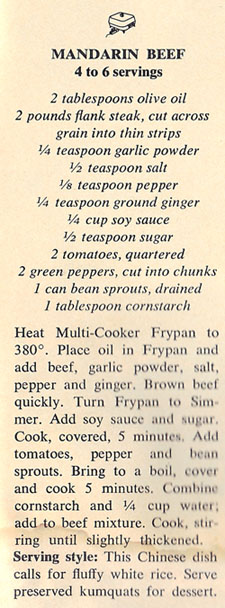 I don’t feel like pulling out my electric fry pan, so I’ll just use one of my stove-top frying pans. For the two of us, I’ll halve the recipe. Instead of the canned bean sprouts, I will substitute with julienned zucchini (I would have used fresh bean sprouts, but forgot to buy them!). I did have mushrooms, so I used them in this dish. And I’ll use fresh ginger and garlic. Tomatoes and fresh ginger and garlic remind me of the base for many dishes my daughter cooked for us in Togo. I think we will like this Mandarin Beef.
I don’t feel like pulling out my electric fry pan, so I’ll just use one of my stove-top frying pans. For the two of us, I’ll halve the recipe. Instead of the canned bean sprouts, I will substitute with julienned zucchini (I would have used fresh bean sprouts, but forgot to buy them!). I did have mushrooms, so I used them in this dish. And I’ll use fresh ginger and garlic. Tomatoes and fresh ginger and garlic remind me of the base for many dishes my daughter cooked for us in Togo. I think we will like this Mandarin Beef.
- 12-16 ounces flank steak, cut across the grain into very thin strips
- 2 cloved garlic, chopped fine
- 1 small piece of fresh ginger, grated
- salt and pepper to taste
- 2 tablespoons soy sauce
- 1/4 teaspoon sugar
- one tomato, quartered
- 1 small green pepper, cut into chunks
- fresh bean sprouts, or julienned zucchini
- sliced mushrooms (optional)
- 1 tablespoon cornstarch dissolved in a little water
Heat a little oil in a wok or fry pan. Add the beef, garlic, ginger, and salt and pepper, and brown the beef over fairly high heat.
Turn down the heat and add the soy sauce and sugar and cook and stir about 5 minutes. Add the tomatoes, green pepper, bean sprouts (or zucchini), and mushrooms and cover and cook about 5 minutes. Add the cornstarch/water mixture, and cook and stir until the dish is slightly thickened.
Serve over rice (I used jasmine rice).
Below is a photo of the meat and vegetables ready for the stir fry.

I totally forgot to take a photo of the cooked meal! It smelled so good and we were hungry – that’s my excuse. It was very good and I would make it again.

 I have a set of twelve Encyclopedia of Cookery volumes and this is the tenth of that set – I covered the first nine in previous posts. I’ve enjoyed all of them so far! This volume covers curious and helpful information about foods from (q)uail to (sor)rel.
I have a set of twelve Encyclopedia of Cookery volumes and this is the tenth of that set – I covered the first nine in previous posts. I’ve enjoyed all of them so far! This volume covers curious and helpful information about foods from (q)uail to (sor)rel. “Quantity cooking” is covered in about ten pages of handy hints, instructions, and recipes. Largely it is for homecooks who need to cook for community events, family gatherings, and bake sales. “Quenelles” are fish dumplings (I made these once, years ago). “Quiche” is “a savory baked custard tart thought to have originated in Lorraine, a province of eastern France bordering on Germany”. The word quiche derives from a word from a French-German dialect that means kuchen, or “cake” (and I have a longing for a kuchen I once had). Mother labelled as “delicious” the recipe for “Quiche Lorraine with Swiss Cheese”.
“Quantity cooking” is covered in about ten pages of handy hints, instructions, and recipes. Largely it is for homecooks who need to cook for community events, family gatherings, and bake sales. “Quenelles” are fish dumplings (I made these once, years ago). “Quiche” is “a savory baked custard tart thought to have originated in Lorraine, a province of eastern France bordering on Germany”. The word quiche derives from a word from a French-German dialect that means kuchen, or “cake” (and I have a longing for a kuchen I once had). Mother labelled as “delicious” the recipe for “Quiche Lorraine with Swiss Cheese”.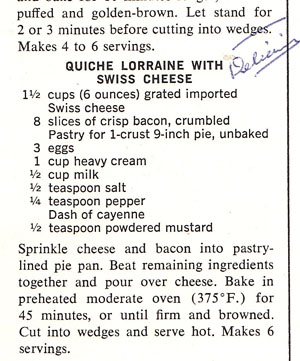 Rabbit, raccoon, radish, rampion (a bellflower used for its edibible root and tender young leaves). “Ratatouille” is a stew or casserole that includes eggplant, zucchini, and green pepper. A “Recipe” is: “a formula for preparing a dish. In old-fashioned usage the words ‘receipt’ or ‘rule’ were often used to mean the same thing.” Aha, back to formulas and chemistry. “Reindeer”! I hope I never have to cook one, but at least now I have a recipe.
Rabbit, raccoon, radish, rampion (a bellflower used for its edibible root and tender young leaves). “Ratatouille” is a stew or casserole that includes eggplant, zucchini, and green pepper. A “Recipe” is: “a formula for preparing a dish. In old-fashioned usage the words ‘receipt’ or ‘rule’ were often used to mean the same thing.” Aha, back to formulas and chemistry. “Reindeer”! I hope I never have to cook one, but at least now I have a recipe.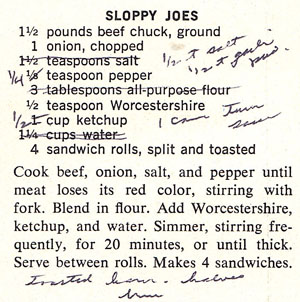 I like a few of the recipes in this section, but like salads, I usually make sandwiches “on the go”, or from ideas picked up from restaurants. Many of the sandwich recipes in this book employ sandwich fillings (kind of like our current-day tuna and chicken salads) that employ a variety of ingredients, including sardines, chopped liver, tongue, or eggs. I might make the “Ham Salad Rolls” 1604, with diced cooked ham, cabbage, celery, green pepper, egg, mustard, and salad dressing on a hot dog roll. There are also recipes for a variety of hot, cold, and open-faced sandwiches.
I like a few of the recipes in this section, but like salads, I usually make sandwiches “on the go”, or from ideas picked up from restaurants. Many of the sandwich recipes in this book employ sandwich fillings (kind of like our current-day tuna and chicken salads) that employ a variety of ingredients, including sardines, chopped liver, tongue, or eggs. I might make the “Ham Salad Rolls” 1604, with diced cooked ham, cabbage, celery, green pepper, egg, mustard, and salad dressing on a hot dog roll. There are also recipes for a variety of hot, cold, and open-faced sandwiches.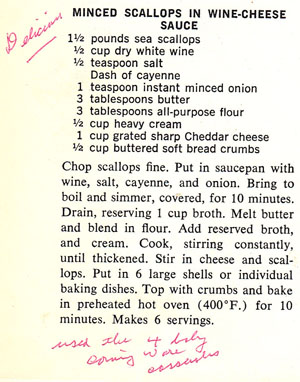
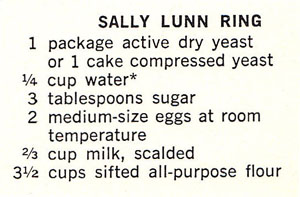
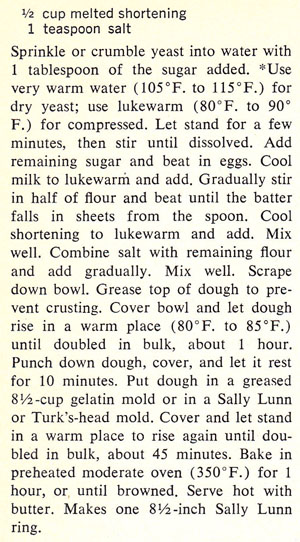
 After the second rise, the dough is not quite to the top of the loaf pan. I let it rise in the pan for 40 minutes because I wanted it higher. Still, I went ahead and put it in the oven.
After the second rise, the dough is not quite to the top of the loaf pan. I let it rise in the pan for 40 minutes because I wanted it higher. Still, I went ahead and put it in the oven.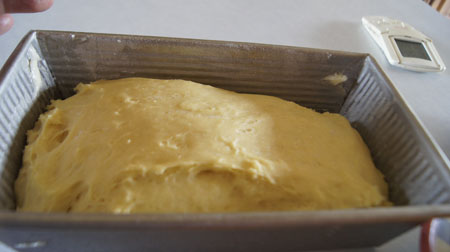 And voila! After baking the bread was just over the top of the pan, and dark golden brown. The crumb of the bread was perfect.
And voila! After baking the bread was just over the top of the pan, and dark golden brown. The crumb of the bread was perfect. This Sally Lunn bread is rich with eggs, milk, and butter, but not too sweet with sugar. The flavor is reminiscent of a brioche. The “crumb” is between a yeast bread and cake in texture. I served it with a dollop of ice cream and a lot of fresh raspberries for dessert. The next day(s), it was great toasted with jam for breakfast. Yay for Sally Lunn!
This Sally Lunn bread is rich with eggs, milk, and butter, but not too sweet with sugar. The flavor is reminiscent of a brioche. The “crumb” is between a yeast bread and cake in texture. I served it with a dollop of ice cream and a lot of fresh raspberries for dessert. The next day(s), it was great toasted with jam for breakfast. Yay for Sally Lunn!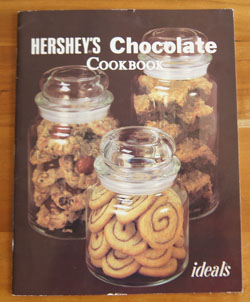 This is one of four Hershey’s cookbooks in my cookbook database. I can’t find the publication date anywhere in my copy, but online photos and details of the same book on Amazon claim “1982” as the date.
This is one of four Hershey’s cookbooks in my cookbook database. I can’t find the publication date anywhere in my copy, but online photos and details of the same book on Amazon claim “1982” as the date. Mother did not mark any of the recipes! This is unusual for her, especially for cookie, pie, and cake recipes, which include all of the recipes in this cookbook.
Mother did not mark any of the recipes! This is unusual for her, especially for cookie, pie, and cake recipes, which include all of the recipes in this cookbook.
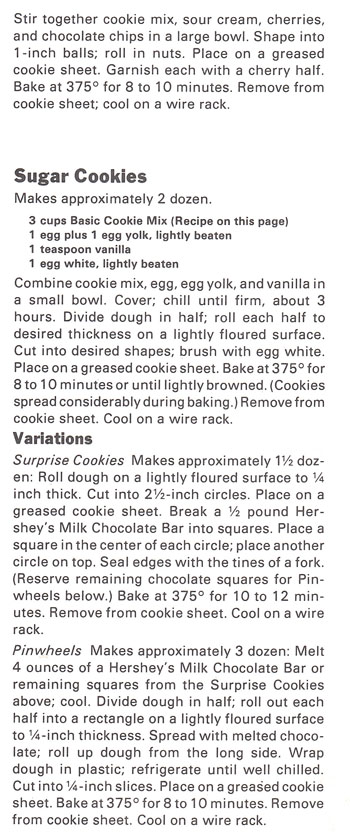 I’m not sure I’ll always want to make “cookie mix” and then the cookies, so I made a half recipe of the mix, then measured it. It made enough for two different types (or batches) of cookies.
I’m not sure I’ll always want to make “cookie mix” and then the cookies, so I made a half recipe of the mix, then measured it. It made enough for two different types (or batches) of cookies.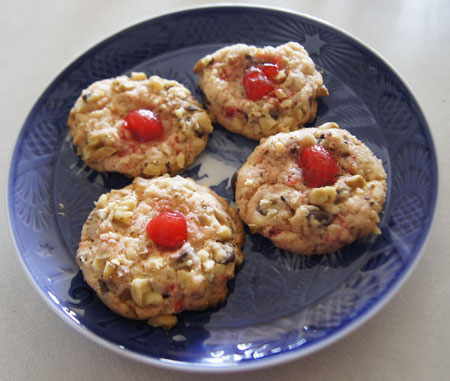 Wow, were these ever good! Very, very tender. I realized as I made the dough that this is how I make pie crust, by first combining the flour-sugar and shortening, then blending in the wet ingredients. Usually cookies are made by combining the sugar and shortening and any wet ingredients, then adding the dry ingredients. The result of the “Basic Cookie Dough” method is that the cookies taste tender, like pie crust.
Wow, were these ever good! Very, very tender. I realized as I made the dough that this is how I make pie crust, by first combining the flour-sugar and shortening, then blending in the wet ingredients. Usually cookies are made by combining the sugar and shortening and any wet ingredients, then adding the dry ingredients. The result of the “Basic Cookie Dough” method is that the cookies taste tender, like pie crust.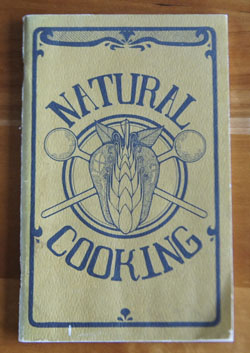 The title page of this booklet is marked “$1.50” in very neat handwriting. My guess is that I bought it in a Boulder bookstore, way back when. Today I could buy it for $3.95 on Amazon.
The title page of this booklet is marked “$1.50” in very neat handwriting. My guess is that I bought it in a Boulder bookstore, way back when. Today I could buy it for $3.95 on Amazon. The trend for whole grains continues today (2017). I like them because they have much more flavor than plain white bread, or white rice. Whole grains have a low glycemic index, touted in
The trend for whole grains continues today (2017). I like them because they have much more flavor than plain white bread, or white rice. Whole grains have a low glycemic index, touted in 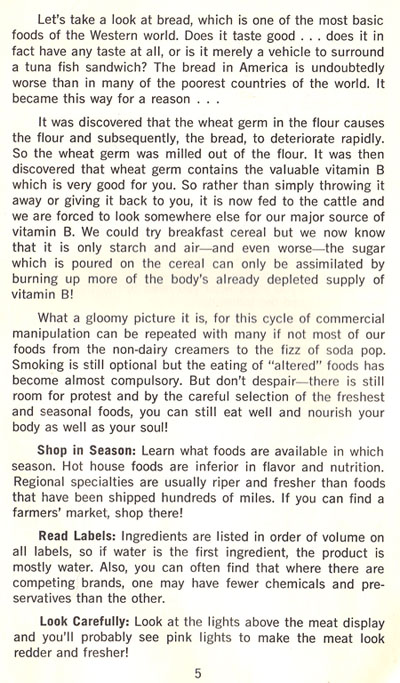


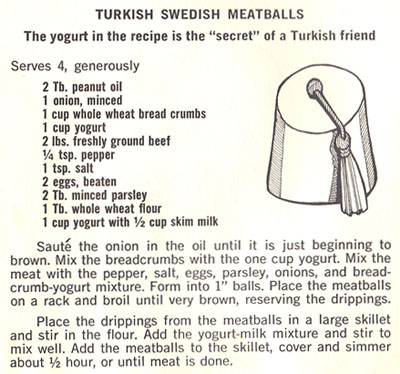 I cut the recipe in half for the two of us. I found the meatballs too sloppy as I formed them, so I added more breadcrumbs. I found it very hard to stir the whole wheat flour into the drippings, so next time I’d use white (AP) flour. (Not worth the trouble using whole grains for this small amount of flour, if it doesn’t work.) Below is my version of this recipe.
I cut the recipe in half for the two of us. I found the meatballs too sloppy as I formed them, so I added more breadcrumbs. I found it very hard to stir the whole wheat flour into the drippings, so next time I’d use white (AP) flour. (Not worth the trouble using whole grains for this small amount of flour, if it doesn’t work.) Below is my version of this recipe.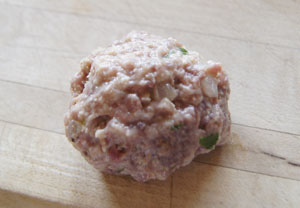 Set the meatballs to rest on a plate or breadboard. Heat your oven to broil. Find a clean broiler pan, or use a rack set over a pan to catch the drippings. Lightly oil the broiler pan or the rack, then place the meatballs on it. Broil the meatballs until they are very brown. This took me 5-10 minutes; I rotated the pan often and turned the oven to low-broil about halfway through.
Set the meatballs to rest on a plate or breadboard. Heat your oven to broil. Find a clean broiler pan, or use a rack set over a pan to catch the drippings. Lightly oil the broiler pan or the rack, then place the meatballs on it. Broil the meatballs until they are very brown. This took me 5-10 minutes; I rotated the pan often and turned the oven to low-broil about halfway through.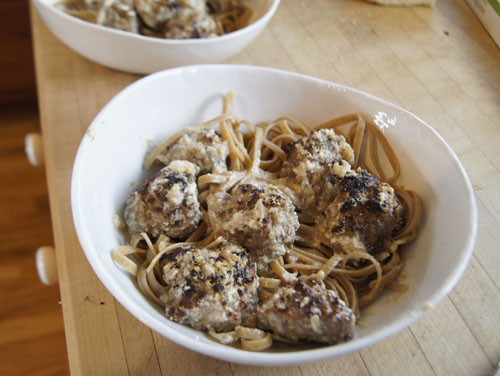 I was surprised at how well these went over! The first comment from my dining-partner was “ummmm, these are good!” I too liked them. Full of flavor and nice and moist.
I was surprised at how well these went over! The first comment from my dining-partner was “ummmm, these are good!” I too liked them. Full of flavor and nice and moist.